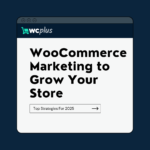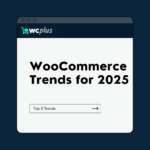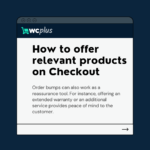Marketing your WooCommerce store effectively is no small task. With so many options available—from social media to search engine optimization—it’s easy to feel overwhelmed. But here’s the thing: you don’t need to do everything. Instead, focusing on the right strategies can make all the difference in driving traffic, increasing conversions, and growing your business.
As we head into 2025, the e-commerce landscape is more competitive than ever, and staying ahead means making informed decisions about where to invest your time and resources. Whether you’re just starting out or looking to scale, understanding the most impactful WooCommerce marketing strategies can help you reach your goals.
In this article, we’ll explore five proven strategies that every WooCommerce store owner should consider. From leveraging SEO to making the most of social media, these tips are designed to be actionable, practical, and results-driven.
Email Marketing
Email marketing remains a cornerstone of successful e-commerce strategies, offering a direct and cost-effective way to connect with your audience. With its potential to generate a return of $36 for every $1 spent, it’s a must-have for WooCommerce store owners looking to grow their business in 2025.
Building a High-Quality Email List
The first step in email marketing is creating a list of subscribers genuinely interested in your products. Avoid buying email lists, as they often lead to low engagement and can harm your sender reputation. Instead, focus on organic methods to grow your list. Add an opt-in form during checkout, include a pop-up on your website offering a discount for new subscribers, or create a lead magnet like a free guide or exclusive access to sales.
Segmentation for Better Results
Not all customers are the same, so your emails shouldn’t be either. Email segmentation allows you to group your subscribers based on their behavior, location, or purchase history. For example:
- Customers who haven’t made a purchase in three months might receive a re-engagement email with a small discount to encourage them back.
- Frequent buyers could be sent early access to new collections as a reward for their loyalty.
- Visitors who abandoned their cart should receive a friendly reminder about the items they left behind.
Segmentation ensures your emails feel personalized and relevant, leading to higher open and click-through rates.
Automating Key Email Campaigns
Automation saves time and ensures your customers receive the right message at the right moment. Here are a few essential automated email campaigns every WooCommerce store should implement:
- Welcome Emails: First impressions matter. When someone subscribes to your list, send a warm welcome that introduces your brand and highlights your best products or services.
- Abandoned Cart Emails: Recover potential lost sales by reminding customers about the items they left behind. Sweeten the deal with free shipping or a small discount.
- Post-Purchase Emails: After a customer completes a purchase, thank them and suggest complementary products. For example, if they bought a camera, recommend accessories like a lens or tripod.
Designing Emails That Convert
Your email content should be visually appealing, mobile-friendly, and action-oriented. Use professional templates that align with your branding and ensure the most important information—like a discount code or new product announcement—is immediately visible.
Clear calls-to-action (CTAs) are essential. Instead of vague buttons like “Click Here,” use specific phrases like “Shop the Sale” or “Explore New Arrivals.” Testing different subject lines, email designs, and CTAs can help you identify what works best for your audience.
Measuring Success and Improving Over Time
No email marketing strategy is complete without monitoring results. Pay attention to key metrics like open rates, click-through rates, and conversions. Tools like Mailchimp and Klaviyo, which integrate with WooCommerce, offer detailed analytics to help you refine your approach.
Practical Example
Imagine a customer adds a product to their cart but doesn’t complete the purchase. An abandoned cart email is automatically sent an hour later, reminding them of the item and offering a 10% discount if they complete their purchase within 24 hours. The customer clicks the link, finishes the transaction, and feels appreciated by your store’s personalized approach.
By leveraging email marketing effectively, you can foster lasting relationships, recover lost sales, and drive repeat purchases—all while keeping your WooCommerce store at the forefront of your customers’ minds.
Optimize Your WooCommerce Store for SEO
Search Engine Optimization (SEO) is the backbone of any successful online store. It helps your WooCommerce store rank higher on search engines, making it easier for potential customers to discover your products. With most online shopping journeys starting on Google, neglecting SEO is not an option.
Understanding the Importance of SEO
SEO isn’t just about driving traffic; it’s about attracting the right audience—shoppers who are actively searching for the products or services you offer. A well-optimized WooCommerce store ensures that your pages rank for relevant keywords, improving visibility and leading to more conversions.
For example, if you sell handmade candles, you want your product pages to appear when someone searches for “handmade soy candles” or “eco-friendly candles online.” That’s where SEO comes in.
On-Page SEO: Optimizing Individual Pages
On-page SEO involves optimizing elements on your website to make it more search engine-friendly. Here’s how to get started:
Use Descriptive Product Titles and Meta Descriptions:
Your product titles should include relevant keywords without sounding unnatural. For example, instead of “Lavender Candle,” use “Handmade Lavender Soy Candle – Eco-Friendly.”
Write meta descriptions that clearly explain what the product is while enticing users to click.
Focus on Image Optimization:
Use high-quality images but compress them to reduce load time. Include descriptive file names (e.g., “lavender-soy-candle.jpg”) and alt text for accessibility and SEO purposes.
Organize Your Content with Headings:
Break your content into sections using headers (H1, H2, H3) that include keywords naturally. This not only improves readability but also helps search engines understand your page.
Internal Linking:
Link related products or blog posts to keep visitors on your site longer. For example, a blog about “Candle Care Tips” could link to your candle product pages.
Technical SEO: The Foundation for Better Rankings
While on-page SEO is essential, technical SEO ensures your site functions efficiently. Here’s what to focus on:
Improve Website Speed:
Slow-loading websites lose visitors quickly. Use caching plugins, compress images, and choose a reliable hosting provider to improve load times.
Enable SSL for Security:
Search engines favor sites with HTTPS. Make sure your WooCommerce store has an SSL certificate to protect customer data.
Make Your Store Mobile-Friendly:
With the majority of users shopping on mobile devices, a responsive design is critical. Test your site to ensure it looks great and functions smoothly on all screen sizes.
Create a Sitemap:
Generate and submit a sitemap to search engines like Google. This helps them index your site more effectively.
Keyword Research for WooCommerce
Identifying the right keywords is at the heart of SEO. Use tools like Google Keyword Planner or SEMrush to find terms your audience is searching for. Focus on:
-
Product-Specific Keywords: e.g., “organic body lotion” or “customizable mugs.”
- Long-Tail Keywords: These have lower competition and higher intent, such as “where to buy eco-friendly candles near me.”
Measuring and Adjusting SEO Performance
SEO isn’t a one-and-done process—it requires regular monitoring and adjustments. Use tools like Google Analytics and Google Search Console to track:
- Search rankings for your target keywords.
- Traffic to product pages.
- Bounce rates and conversion rates.
If certain pages aren’t performing well, consider rewriting the content, adding more internal links, or improving page speed.
Practical Example
Let’s say you sell fitness gear. By optimizing a product page for the keyword “best resistance bands for beginners,” your page appears on the first page of search results. When users click through, they find a fast-loading, mobile-friendly page with clear product details, leading to higher sales.
By investing time and effort into SEO, you can make your WooCommerce store more visible to your ideal customers, attract organic traffic, and boost sales without relying solely on paid ads.
Social Media Marketing
Social media is more than just a place to connect with friends; it’s a powerful tool for driving traffic, engaging with your audience, and building brand awareness for your WooCommerce store. With billions of active users on platforms like Instagram, Facebook, Pinterest, and TikTok, your potential customers are already there—it’s just a matter of reaching them.
Why Social Media Matters for WooCommerce Stores
Social media offers WooCommerce store owners a way to showcase their products, tell their brand story, and interact directly with their customers. The visual nature of platforms like Instagram and Pinterest makes them particularly effective for promoting physical products, while Facebook and TikTok can drive targeted traffic through ads and viral content.
For instance, a WooCommerce store selling handmade jewelry can use Instagram to post photos of their designs, run giveaways to boost engagement, and share behind-the-scenes videos to build a connection with followers.
Strategies to Maximize Social Media Success
Create Shoppable Posts
Platforms like Instagram and Facebook allow you to tag products directly in your posts, linking them back to your WooCommerce store. This makes it easy for customers to browse and shop without leaving their favorite app. Setting up shoppable posts requires linking your WooCommerce store to your social accounts via plugins or integrations like Facebook for WooCommerce.
Post Consistently with a Strategy
Consistency is key to staying visible. Develop a content calendar with a mix of product promotions, user-generated content, and educational or entertaining posts. For example:
Post new arrivals or seasonal collections.
Share customer testimonials or reviews.
Offer tips or tutorials related to your products.
Engage with Your Audience
Social media isn’t just about posting—it’s about building relationships. Respond to comments, answer questions, and participate in conversations. Engaging with your audience shows you care and builds trust in your brand.
Run Targeted Ads
Social media platforms have robust advertising tools that allow you to target specific audiences based on their demographics, interests, and behavior. A well-targeted Facebook or Instagram ad can significantly boost traffic and conversions for your WooCommerce store.
Leverage Influencer Marketing
Collaborating with influencers can help you reach new audiences. Focus on micro-influencers (those with smaller but highly engaged followings) who align with your brand values and niche. For example, a fitness influencer can showcase your workout gear to their audience, driving awareness and sales.
Choosing the Right Platforms
Not all platforms will suit your brand or products. Here’s a quick guide to help you decide:
- Instagram: Ideal for visually appealing products like fashion, home décor, or beauty items.
- Pinterest: Perfect for niche markets like DIY crafts, weddings, or recipes.
- TikTok: Great for fun, creative brands looking to engage a younger audience.
- Facebook: Effective for running ads and engaging in group communities.
Practical Example
Imagine you sell handmade leather wallets. You post a short video on TikTok showing the craftsmanship behind your products, which goes viral and drives traffic to your store. At the same time, you run a Facebook ad targeting users who’ve shown interest in leather goods, offering a 10% discount for first-time buyers. Together, these efforts significantly boost your sales and brand visibility.
Measuring Social Media Success
Track metrics like engagement rate, follower growth, website traffic, and conversions using tools like Facebook Insights, Instagram Analytics, or third-party platforms like Hootsuite. Adjust your strategy based on what performs well—double down on popular content formats and refine underperforming campaigns.
Social media marketing is a dynamic, creative way to connect with your audience and grow your WooCommerce store. By combining organic efforts with paid promotions, you can drive engagement, boost traffic, and turn followers into loyal customers.
Utilize Google Shopping Ads
In the e-commerce world, Google Shopping Ads have become a game-changer for reaching customers who are actively searching for products online. These ads display your products directly at the top of search results, complete with images, prices, and store names, giving potential buyers an instant overview of what you offer.
Why Google Shopping Ads Work for WooCommerce Stores
Unlike traditional search ads, Google Shopping Ads target high-intent shoppers—people who are already looking for specific products. For example, if someone searches for “black leather tote bag,” they’ll see a curated display of relevant products, including yours, with details like price and store name. This makes it easier to capture attention and drive traffic directly to your product pages.
Google Shopping Ads also allow you to stand out visually in search results, which is especially important for product-based businesses. With the ability to showcase multiple items at once, they help customers discover your range and compare options easily.
How to Set Up Google Shopping Ads for WooCommerce
Create a Google Merchant Center Account
The first step is to sign up for a Google Merchant Center account. This platform is where you upload your product data and manage your shopping campaigns. Ensure your store complies with Google’s policies, such as having clear return and shipping policies.
Generate a Product Feed
A product feed is a file that contains all the details about your products, like titles, descriptions, prices, and images. For WooCommerce stores, plugins like “Product Feed PRO for WooCommerce” or “Google Listings & Ads” can help you create and sync this feed automatically.
Link Google Ads to Your Merchant Center
Connect your Merchant Center account with Google Ads to start creating campaigns. This integration ensures your product data flows seamlessly into your ads.
Optimize Product Titles and Descriptions
Use keywords that customers are likely to search for. For example, instead of “Tote Bag,” go for “Black Leather Tote Bag with Pockets.” Keep descriptions clear, concise, and informative.
Set Up and Launch Your Campaign
In Google Ads, create a Shopping campaign and set your budget. Use tools like Smart Shopping campaigns to let Google’s AI optimize your bids and placements based on performance.
Best Practices for Success
Use High-Quality Images
Visual appeal matters. Make sure your product images are professional and clear, as they’re often the first thing customers notice.
Keep Pricing Competitive
Many shoppers compare prices directly in Google Shopping. Ensure your pricing aligns with the market to increase click-through rates.
Leverage Negative Keywords
Add negative keywords to prevent your ads from showing up in irrelevant searches, which helps save your budget for high-intent shoppers.
Track and Optimize Performance
Use Google Ads reporting to analyze key metrics like clicks, impressions, and conversions. Adjust bids and refine product listings based on what’s working.
Practical Example
Let’s say you sell handmade ceramic mugs. When a shopper searches for “custom coffee mugs,” your product ad appears at the top of the search results, showcasing an image of your beautifully crafted mugs, the price, and your store name. The shopper clicks the ad, visits your WooCommerce store, and completes the purchase, all because of the visibility created by Google Shopping Ads.
Measuring ROI on Google Shopping Ads
Use conversion tracking to monitor the performance of your campaigns. Metrics like Return on Ad Spend (ROAS) and Cost Per Conversion will help you determine whether your campaigns are profitable and identify areas for improvement.
Tetargeting to Re-Engage Potential Customers
Not every visitor to your WooCommerce store will make a purchase on their first visit—this is where retargeting comes into play. Retargeting allows you to re-engage potential customers who have interacted with your store but didn’t convert, reminding them of your products and encouraging them to return.
Why Retargeting is Crucial for WooCommerce Stores
Retargeting focuses on high-value prospects: people who have already shown interest in your products. These might include:
- Visitors who browsed your store but didn’t add items to their cart.
- Shoppers who abandoned their carts before completing checkout.
- Customers who made a purchase in the past but haven’t returned.
Instead of trying to attract cold audiences, retargeting serves tailored ads to warm leads, making them far more likely to convert.
How Retargeting Works
Retargeting typically involves tracking customer behavior using cookies or pixel data. For example, if someone visits your store, views a product, but leaves without buying, retargeting allows you to show them ads for that exact product as they browse other websites or social media.
Effective Retargeting Strategies
Cart Abandonment Campaigns
Shoppers abandoning their carts is a common issue. Retarget these customers with reminders about their unfinished purchase. Add a sense of urgency with limited-time discounts or free shipping offers to entice them back.
Dynamic Product Ads
Use dynamic retargeting ads to show potential customers the exact products they viewed on your store. Platforms like Facebook, Instagram, and Google make it easy to run dynamic ads that feel personalized and relevant.
Cross-Selling and Upselling
Retarget past customers by promoting complementary products to what they’ve already purchased. For example, if someone bought a camera, retarget them with ads for accessories like lenses or tripods.
Segment Your Retargeting Audience
Not all customers should receive the same ads. Segment your audience based on behavior, such as:
- First-time visitors who didn’t purchase.
- Repeat customers you want to upsell or cross-sell.
- Visitors who abandoned their cart.
Platforms for Retargeting
Several platforms offer retargeting options:
- Google Ads: Show retargeting ads across Google’s Display Network, including YouTube.
- Facebook and Instagram Ads: Create highly visual retargeting ads for these social platforms.
- Pinterest Ads: Retarget users who have pinned or saved similar products.
Best Practices for Retargeting
- Don’t Overdo It: Avoid bombarding users with too many ads. Limit ad frequency to avoid appearing pushy or intrusive.
- Test Creative Variations: Experiment with different ad copy, images, and offers to find out what resonates best.
- Include Clear CTAs: Ensure your ads have a strong and compelling call-to-action, like “Return to Your Cart” or “Shop the Sale.”
- Use Retargeting Exclusively for Warm Leads: Focus on users who’ve already shown interest in your store, as they’re the most likely to convert.
Practical Example
Imagine a visitor browses your WooCommerce store and views a pair of leather boots but doesn’t make a purchase. A few days later, they see an Instagram ad showcasing the same boots with a special offer: “Get 10% off today only!” Feeling reminded and incentivized, they return to your store and complete the purchase.
Measuring Retargeting Success
Track metrics like click-through rates (CTR), conversions, and Return on Ad Spend (ROAS) to gauge your retargeting campaigns’ effectiveness. Use these insights to refine your targeting, messaging, and ad placements.
Retargeting ensures that your WooCommerce store remains top of mind for potential customers, turning casual browsers into loyal buyers. By delivering the right message at the right time, you can significantly increase conversions and boost revenue.
Wrapping Up
Marketing a WooCommerce store in 2025 isn’t just about following trends—it’s about understanding your audience and delivering value through consistent, thoughtful strategies. The digital landscape continues to evolve, and standing out requires more than just great products. It’s about creating experiences that resonate, building trust with your customers, and being adaptable in how you reach them.
Whether it’s through personalized email campaigns, leveraging the power of Google Shopping Ads, or re-engaging potential customers through retargeting, the key is to approach each tactic with purpose. Remember, successful marketing isn’t about doing everything; it’s about doing the right things well.
Looking to implement these strategies and take your WooCommerce store to the next level? Start by exploring tools and resources that can streamline your efforts. Tools like WC Plus can simplify checkout processes, improve user experiences, and ensure your store is ready to grow in today’s competitive market.
Every step you take toward improving your marketing is a step toward building a store that not only stands out but thrives.







